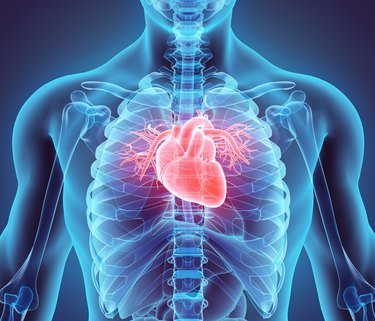
Your cardiovascular system consists of your heart, blood vessels and blood, which function together as a liquid transport network. This system delivers oxygen and nutrients to your body and picks up waste products to be eliminated. It also distributes important proteins, hormones and other chemicals to different parts of your body and helps control your body temperature. Your heart serves as the pump that propels blood through your cardiovascular system. Different types of blood vessels--including arteries, veins and capillaries--possess distinctive features that facilitate their varied functions in your circulatory system.
Heart
Video of the Day
Your heart is relatively small, about the size of your fist, and typically weighs approximately 9 to 12 ounces. Despite it's rather diminutive size, your heart is a powerful workhorse. The walls of your heart consist almost entirely of specialized muscle cells that occur only in your heart. Under the direction of an electrical signaling system, your cardiac muscle tissue contracts in a regular, coordinated manner with each heartbeat.
Video of the Day
Heart Chambers
Your heart includes 4 internal chambers that collect blood to be pumped to your lungs and body. The two chambers on the right side of your heart control blood flow to your lungs, or the pulmonary circulation. The two chambers on the left side of your heart control blood flow to the rest of your body, or the systemic circulation.
The two chambers at the top of your heart are called the right atrium and left atrium. The right atrium receives blood from your body to be delivered to your lungs. The left atrium receives blood from your lungs to be distributed to the rest of your body. The two chambers located at the bottom of your heart--the right ventricle and the left ventricle--pump blood away from the heart. The right ventricle pumps blood to your lungs to pick up more oxygen. The left ventricle pumps oxygen-rich blood to the rest of your body.
Heart Valves
Four valves control blood flow through your heart to ensure that it moves in one direction during heart contractions. The tricuspid valve separates the right atrium from the right ventricle. The pulmonic valve at the exit of your right ventricle opens to allow blood flow to your lungs. The mitral valve separates the left atrium from the left ventricle. The aortic valve at the exit of your left ventricle opens to permit blood flow from the heart to the rest of your body.
Blood Vessels
Arteries and Veins
Your blood vessels are hollow tubes of various sizes that carry blood to and from your heart. Blood vessels that carry blood away from the heart are called arteries. Most arteries carry oxygen-rich blood. Because your arterial circulation is under high pressure, arteries possess thick, elastic, muscular walls.
Blood vessels that carry blood to your heart are called veins. Most veins carry oxygen-poor, or deoxygenated, blood. Your venous circulation is a low-pressure system, so veins have thinner, less elastic walls compared to arteries. Some veins also possess one-way valves that help blood move toward your heart and keep it from pooling due to gravity.
Capillaries
The arteries and veins branch into smaller blood vessels called arterioles and venules. The arterial and venous circulation are separated by a large network of tiny blood vessels called capillaries. These minute, thin-walled vessels allow nutrients, oxygen, carbon dioxide, and some cells and small chemicals to cross between the circulation and your body tissues. Your body contains approximately 10 billion capillaries, most shorter than the tip of pencil. Your capillaries complete the final step in the pick-up/delivery function of your cardiovascular system.
Blood
Your blood is the transport fluid of your circulatory system. The circulatory system of an average adult contains approximately 8 to 10 pints of blood. Your blood consists of a mixture of solids called formed elements and liquid called plasma.
Formed Elements
The formed elements of your blood include red blood cells, white blood cells and platelets. Red blood cells carry oxygen from your lungs to your body tissues. They also pick up carbon dioxide from your tissues, which is then eliminated through your lungs when you exhale. The white blood cells in your blood are part of your immune system and help you fight infections. Platelets are tiny cellular fragments that clump together to form the matrix of blood clots to stop bleeding. The formed elements typically account for approximately 45 percent of your blood volume.
Plasma
The cellular parts of your blood are suspended in a protein-rich liquid called plasma, which accounts for approximately 55 percent of your blood volume. This liquid contains a broad array of nutrients, electrolytes, proteins, hormones and other chemicals. Most blood tests measure the levels of specific chemicals or elements in your plasma, which can help your doctor assess the status of your various body systems and their functions.
Reviewed and revised by: Tina M. St. John, M.D.
Is this an emergency? If you are experiencing serious medical symptoms, please see the National Library of Medicine’s list of signs you need emergency medical attention or call 911.